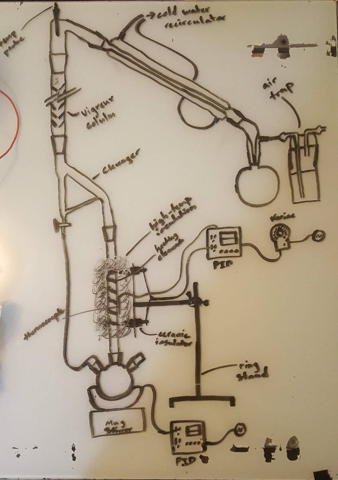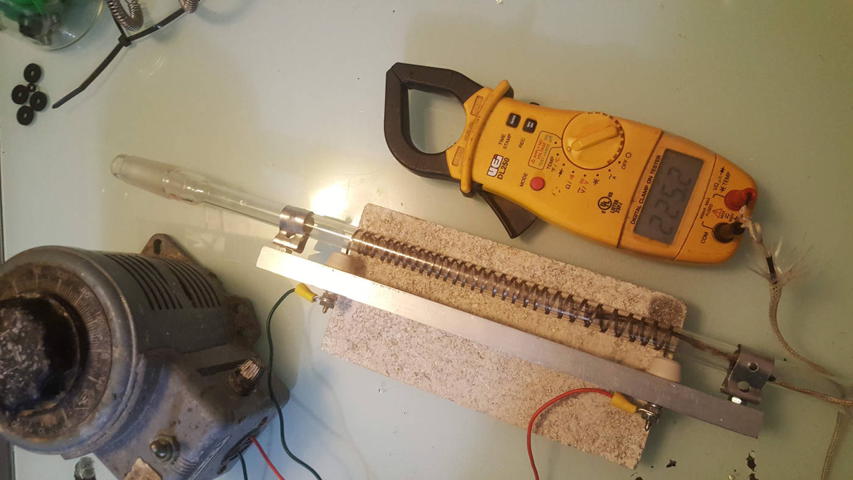Work Log
TODO
- [ ] design
13 Apr 2020
Indigo carmine might work as a sodium hydroxide indicator. At a pH below 11.6 it turns blue.
A microreactor would be ideal for the amateur. A few ml per hour is sufficient for us. Unfortunately, vapor nitration of alkanes proceeds via a free radical mechanism. Contact with reactor walls (made of stainless steel) extinguishes radicals resulting in single digit conversions. (Burns and Ramshaw 2002)
Microreactors at room temperature and relatively low pressure do work for nitrating toluene. (Halder, Lawal, and Damavarapu 2007) The researchers basically pushed toluene and nitric acid through stainless or teflon capillary tubing. Even at room temperature and azeotropic nitric acid, decent yields were obtained. This could be a cool use of one of my extra HPLC pumps…
22 Jul 2019
Discovered molten-salt reactors. Probably a much safer alternative to tubular reactors for the amateur. (Adams 1961)
In brief, the reactants are bubbled through a molten, eutectic mixture of nitrate salts. This provides better temperature control and even mixing.
Calcium nitrate is considerably cheaper than potassium or sodium. This is often sold as a double salt of calcium carbonate and ammonium nitrate, however. Ammonium nitrate decomposes around 200C, so this wouldn’t work.
12 Jul 2019
- nitrating ketones results in only 9-13% yield (Wang and Sherwin 1985)
- mercaptans are added to consumer hydrocarbons -could contaminate
- contamination can be removed by bubbling through NaOH solution (Jones, Hatcher, and Weiland 2013)
- below pH 12.5 efficiency falls below 80% (figure 7; pp 7)
- recycling the propane by scrubbing out CO/CO2? (Lamb, Bray, and Frazer 1920)
- oxidation might require mixed copper/manganese oxides (Hutchings et al. 1996; Krämer et al. 2006)
Bibliography
Adams, Frank Slates. 1961. “Vapor Phase Nitration of Butane in a Fused Salt Reactor.” Dissertation, Iowa State University.
Burns, John Robert, and Colin Ramshaw. 2002. “A Microreactor for the Nitration of Benzene and Toluene.” Chemical Engineering Communications 189 (12): 1611–28. https://doi.org/10.1080/00986440214585.
Halder, Raghunath, Adeniyi Lawal, and Reddy Damavarapu. 2007. “Nitration of Toluene in a Microreactor.” Catalysis Today 125 (1-2): 74–80. https://doi.org/10.1016/j.cattod.2007.04.002.
Hutchings, Graham J., Ali A. Mirzaei, Richard W. Joyner, M. Rafiq H. Siddiqui, and Stuart H. Taylor. 1996. “Ambient Temperature CO Oxidation Using Copper Manganese Oxide Catalysts Prepared by Coprecipitation: Effect of Ageing on Catalyst Performance.” Catalysis Letters 42 (1-2): 21–24. https://doi.org/10.1007/BF00814462.
Jones, Clayton E, Nathan A Hatcher, and Ralph H Weiland. 2013. “Mercaptans Removal from Gases by Absorption into Amines and Caustic.”
Krämer, M., T. Schmidt, K. Stöwe, and W.F. Maier. 2006. “Structural and Catalytic Aspects of SolGel Derived Copper Manganese Oxides as Low-Temperature CO Oxidation Catalyst.” Applied Catalysis A: General 302 (2): 257–63. https://doi.org/10.1016/j.apcata.2006.01.018.
Lamb, Arthur B., William C. Bray, and J. C. W. Frazer. 1920. “The Removal of Carbon Monoxide from Air.” Journal of Industrial & Engineering Chemistry 12 (3): 213–21. https://doi.org/10.1021/ie50123a007.
Wang, Shu-Shieh P., and Martin B. Sherwin. 1985. Preparation of nitro compounds by vapor phase nitration of ketones. US4517393A, issued May 1985. https://patents.google.com/patent/US4517393A/en?oq=4517393.

